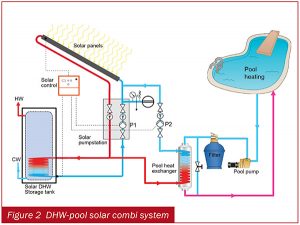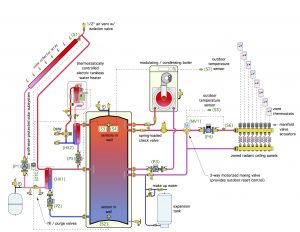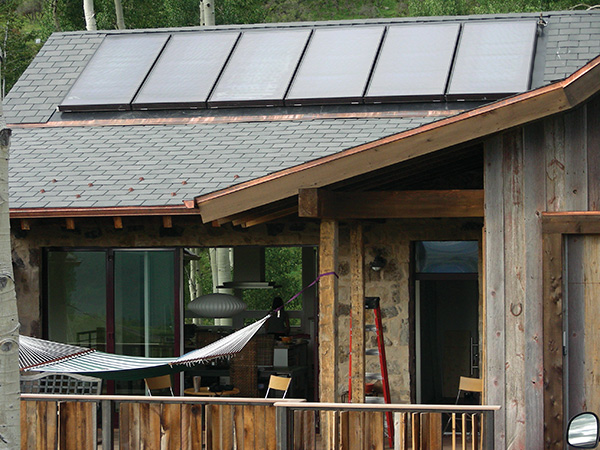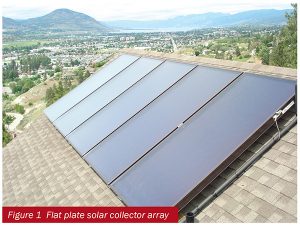
How effectively are contractors integrating solar into hydronic systems?
August 28, 2018 | By Rob Waters
There is currently a lot of attention being devoted to reducing greenhouse gas (GHG) emissions from buildings. One of the primary methods that governments are using to meet their goals is to tighten up building codes to require super-insulated and super-airtight building construction that require much less energy to heat.
The path forward and timing with building codes changes is not clearly defined in all areas yet, but the ultimate target of most governments seems to be to get to a level of Net Zero Energy Ready standard by about 2030. Net Zero Ready homes will have space heating requirements that are almost 90 per cent less than current building code levels. These newly constructed low energy homes will have dramatically reduced energy consumption and emissions.
Making new homes more efficient is only a part of the solution, as they only make up a small part of the entire building stock. Existing buildings will still account for the bulk of emissions from buildings and the vast majority of homes in Canada are heated with natural gas. So another big focus for GHG emission reductions is to transition away from fossil fuel burning equipment altogether, and start utilizing low carbon heating systems.
There are various “renewable” heating options that can be considered low carbon, such as electric resistance, air and water source heat pumps, biomass and solar thermal. With my background in the solar thermal (ST) and hydronic heating industries, I am often asked about integrating solar thermal into hydronic systems. What kind of integrated systems are possible? Are any of these types of systems being used?
In response to the first question, there are numerous possibilities for integrating ST with hydronics. Unfortunately the answer to the second is there are very few of these systems being installed. Before looking more closely at the types of system possibilities, let’s look at the current state of solar heating.
Solar thermal water heating suffers from several significant market barriers, with the primary issue being the economics. There is plenty of proven and reliable ST heating equipment available in the market, especially from some European suppliers, but the initial capital cost for equipment and installation is quite high. Combine this high cost for ST heating with the low cost of natural gas, and the resulting system paybacks are very long.
The ST industry in Canada also does not currently have any government support incentives to help out.
Steve Royce is the solar thermal specialist at Viessmann Manufacturing Company, and he says “There is lots of interest in solar thermal heating, but the cost generally scares people away. This is especially true after they realize that the solar system will only provide supplemental heat, and that you still require a backup heating system.”
Another barrier facing ST water heating is the lack of awareness in the industry about the capabilities of solar systems, and the installation requirements. Royce says that most people have unreal expectations about the winter heat output of a solar system. “I get requests all the time from people who say “I want to heat my home with solar.” I have to explain to them that solar systems do create plenty of heat, but it comes primarily in the spring and fall shoulder seasons.”
There is also an issue with a lack of knowledgeable solar heating contractors. According to Royce, “Even good hydronic guys are often dumbfounded with solar system design and installation.” He tells me “There are very few contractors out there who have the technical knowledge and skills to properly install a solar combi system. We end up dealing with many systems, which have installation or design issues.”
Market pressure from other types of renewables, especially solar photovoltaics and heat pump technologies have also slowed down the use of solar thermal heating systems. Hydronics expert and HPAC columnist John Siegenthaler devoted an entire section to solar thermal heating systems in his 2016 book Heating with Renewable Energy. This book is one of the best resources available for anyone who wants to know how to properly design and install solar thermal heating.
 Siegenthaler, admits however that “solar PV is so dominant now that solar thermal has suffered.” He still sees interest in solar thermal, but says “people are tending to put their money where the best bang for the buck is, and right now that is in grid connected or net-metered solar PV systems.”
Siegenthaler, admits however that “solar PV is so dominant now that solar thermal has suffered.” He still sees interest in solar thermal, but says “people are tending to put their money where the best bang for the buck is, and right now that is in grid connected or net-metered solar PV systems.”
Even with these barriers, solar thermal heating still has a lot to offer for those interested in utilizing renewable energy to reduce fossil fuel use.
There are three primary loads that can be very effectively met by ST heating: domestic hot water heating, pool heating, and supplementing radiant heating systems. The most common application for ST is for DHW heating. SDHW systems tend to be small scale with one or two collectors, and a 200 to 300 gallon storage tank. There are several manufacturers offering packaged SDHW systems, which are pre-designed, have all of the components required, and are fairly easy to install.
Solar combi systems are systems that combine solar DHW heating with space heating and/or pool heating. DHW is a year round load, so it is the ideal “base load” for the system. By adding additional loads, the solar panel array size can be increased and more fossil fuel energy can be displaced.
Solar combisystems tend to be custom systems and the success of these systems is heavily dependent on the designer and installer. There are unique design considerations to solar combi systems, with many being related to how cold and how hot things can get in a ST system.
The potential for wintertime freezing in the solar collector loop must be addressed with either the use of freeze proof glycol in the collector loop, or by using a drainback system. Closed loop glycol systems tend to be more popular, primarily due to the ease with which the supply and return lines can be run from the collector array to the storage tanks. Glycol however must be maintained properly, and can turn nasty if it is exposed to long periods of stagnation.
Drainback systems eliminate the use of glycol, as water is used as the heat transfer medium and it all drains back into the building every time the pump shuts off. To achieve this the challenge of installing the supply and return lines is substantially increased. There is no margin for error in the Canadian climate when using drainback system design.
The inability to shut off the fuel source (sun) can create excessively hot collector loops in the summer months. This often results in collector stagnation, steam formation and glycol damage. These problems often plague many solar combisystems due to the larger size of the collector array.
Even skilled hydronic professionals often make key mistakes related to these two important factors that can dramatically affect system performance and durability. Commonly found issues include: Insufficient solar storage tank volume, undersized expansion tanks, incorrectly located check valves, overly complex control systems, incorrectly piped diverting valves, and systems missing key components.
If you are going to tackle a solar combisystem, here are several key factors that must be addressed to ensure that you have success:
1. Do not try and do too much with solar
While it may be tempting to try and get as much solar support as possible, this can often lead to poor economics, summertime overheating problems, and overly complex designs. Most European combi systems are moderately sized, utilizing storage tank sizes of between 450 to 750 liter, and collector arrays of 10 to 15 m2 (four to six flat plate collectors). These systems have proven to be simpler to design, install and maintain.
2. Simplify the design
Complicated designs with multiple tanks, multiple pumps and diverting valves feeding numerous loads are certainly possible with solar combi-systems. These systems however require skilled designers and knowledgeable installers, complex controls and must be precisely commissioned and maintained.
Royce agrees the simple approach is often the best way. “I find that I primarily recommend simple designs, and often back off on the size of the system. Wherever possible I try and design systems with a single pump, a diverting valve, a dual-coil solar storage tank and simple controls,” he added.
Besides being easier for the contractor to install and commission, these types of systems are also easier for the building owner to understand, and simplify future troubleshooting and maintenance.
Solar panels are similar to condensing boilers, in that they operate more efficiently with low return water temperatures. Therefore, to keep the solar combi systems operating as efficiently as possible it is important to match them up with loads that require low temperature distribution systems. The two best choices for this are swimming pool heating and radiant floor heating systems.
Pool heating makes for a great solar combi system. The spring and summertime load of the pool occurs at the exact time when the days are long and the most solar energy is available.
DHW/pool combi systems are relatively simple designs that use a single DHW storage tank and a solar pool heat exchanger. A second pump or three-way diverting valve will redirect the solar fluid through the pool heat exchanger when the DHW tank has been heated.
It is also possible to have a simple switch the homeowner can activate when they want the pool to have priority and get all of the solar energy. The biggest challenge is often making the connection between the basement where the solar storage tank is located and the solar pool pump which is often out in the back yard somewhere.
Using solar to supplement a radiant heating system is a good combination due to the low water temperature requirements of radiant systems. This is especially true in the spring and fall shoulder seasons when most of the solar space heating support will be produced.

Figure 3 DHW-radiant floor slab combi system Courtesy John Siegenthaler Editor’s note: this figure was incorrect in the print edition
Do not expect huge solar contributions in the coldest part of winter, as this is the time of year with the shortest days and least amount of solar radiation. To keep summertime stagnation issues to a minimum, avoid installing too large a collector array. One way to increase wintertime output, and lessen summer overheating is to consider vertically wall mounting the solar panels, or keep the panel slope very steep (at least 70 degrees from horizontal).
Fortunately solar combi systems have been very popular in Europe for many years and there is design support available to help you avoid design and installation pitfalls.
Several years ago in Europe, ST industry representatives created the “CombiSol Project.” This project resulted in several key documents related to best practices in design and installation of solar combi systems, which can be found at www.combisol.eu. Siegenthaler’s book, which was mentioned earlier, contains detailed schematic layout drawings showing both closed loop design and drainback design solar combi systems.
ST manufacturers also offer an excellent source of design and sizing support for solar combi systems. They should be relied upon to help with system design, selecting the right components and getting them installed correctly. Some will also offer to run a computerized solar analysis using solar simulation software.
Solar combi system performance is very site specific and depends on your location and the solar panel orientation and slope. Simulation programs are great design tools that provide a detailed analysis of the solar system output and performance specific to the parameters of your project. They will also quickly show, with both data and graphs, if a system design is likely to have overheating problems.
A source of free energy, solar combi systems can be a great way to provide a low-carbon heating solution that reduces the reliance on fossil fuel use. They are very effective when paired up with the appropriate system and application. Avoid some of the problems mentioned earlier and get advice from the experts if you are going to tackle one of these systems.
Robert Waters is president of Solar Water Services Inc., which provides training, education and support services to the hydronic industry. He has over 30 years experience in hydronic and solar water heating. He can be reached at solwatservices@gmail.com.






